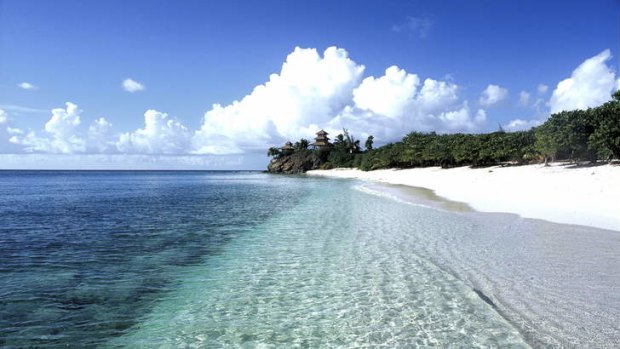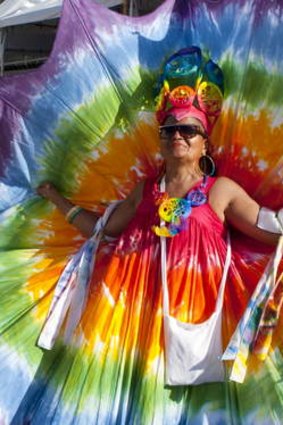
Necker Island.Credit: Getty Images
David Whitley on shack food, turtle-spotting and doing absolutely nothing in the northern hemisphere's glamorous winter getaway.
1. Island-hopping
The differences between the Caribbean islands are part of what makes the region so appealing. Latin spirit in Cuba or the Dominican Republic meets upper-crust British reserve in Antigua, Rastafarianism in Jamaica and slightly snooty French chic in St Barthelemy or Martinique. Ferries connect many of the closer, smaller islands, and the change in vibe when you get off can be dramatic. Weirdest of all is St Martin/Sint Maarten, a tiny island that is half-French and half-Dutch and has distinctive personalities on either side of the unmarked border.

Carnival time in Port of Spain, Trinidad.Credit: Getty Images
2. Cricket
The current West Indies team may not be a patch on the great sides of the 1970s and '80s, but the Caribbean still moves to the rhythm of leather on willow. Pop into pretty much any bar frequented by locals and you'll quickly find yourself in a long, impassioned cricketing debate. The most attractive grounds at which to catch an inter-island game are Arnos Vale in St Vincent (it's on a cliff overlooking the sea) and the mountain-surrounded Beausejour Stadium in St Lucia.
3. Yachting
Cruising is big business in the Caribbean - although the model of giant ships stopping off for duty-free shopping sadly dominates. For a more personal island-hopping experience, yacht charters are the way forward. The likes of Sunsail (sunsail.com) can fix up either bare-boat or crewed charters. If the budget doesn't extend that far, the plush yachts tethered in the marinas make for excellent gawping and photo opportunities. The prime hunting grounds for sail snappers are Antigua and the Virgin Islands.
4. Beaches
The Caribbean stereotypes of white-sand beaches and warm, calm seas are stereotypes for a very good reason - the islands are blessed with some of the finest beaches on Earth. As a general rule, the flatter islands - such as Barbados, Anguilla, Grand Cayman and Antigua - have the sexiest stretches of sand. Beware, though, the most popular ones aren't necessarily the best. For example, in Anguilla, the hype is over squeaky white Shoal Bay East - but the one at Long Bay is arguably prettier and far less crowded.
5. Turtles
Perhaps the most extraordinary beach, however, is Levera Beach in Grenada. This is not because it's particularly beautiful - it's because of what happens there. Huge leatherback turtles - they're the size of coffee tables - struggle up the beach to lay eggs, with the hatchlings running into the sea a few months later. The season runs from March to July, with April being the prime month for watching the big mammas coming in to lay.
6. Shack food
The Caribbean does have some gourmet destinations - Grand Case in St Martin and just about every restaurant on St Barthelemy, for example. But it's the one-dish roadside and beachside shacks that give the true flavour of the region. Expect amazing lechon (suckling pig) in Puerto Rico, spicy jerk chicken in Jamaica, Indian-influenced roti in Trinidad and Tobago, and rich goat curry in Montserrat.
7. Havana
"Get to Cuba before it changes" has been a cliche for quite some time. It has already changed - and massively. But bigger changes are on the way, as the US government eases travel restrictions. For now, Havana still has the crumbling colonial architecture, '50s cars and salsa clubs that give that atmospheric blend of struggle, independence and eerie time warp.
8. Old San Juan
The Caribbean's most appealing city, however, is arguably San Juan in Puerto Rico. Well, the Old San Juan part anyway. It has the occasional dilapidated building, handsome Spanish colonial architecture by the bucket-load, a series of spectacular forts on the cliff-tops and a buzzing bar and restaurant scene. It's the sort of place you wander into at 9am for sightseeing, and out of at 2am, barely able to see from all the dodgy rum a barman has been refilling your glass with.
9. Volcano adventures
The islands that aren't flat tend to be volcanic - and that makes for some rather spectacular hiking. In Dominica, a particularly brutal day hike leads past steaming fumaroles to the extraordinary Boiling Lake, which is exactly what the name suggests. Slogging up La Soufriere on Guadeloupe and the still-smoking Mont Pelee on Martinique are well worth the effort too, but the quirkiest option is Sulphur Springs in St Lucia - which merrily bills itself as the world's only drive-in volcano.
10. What's left of Montserrat
For a reminder that the Caribbean's volcanoes don't always play nice, let a taxi driver take you up to Garibaldi Hill on Montserrat. Following the eruptions of the Soufriere Hills volcano in 1995, most of the island is off-limits - caked in ash, mud and lava. The drive up to Garibaldi Hill takes you through the swirling wind-blown ash and dead trees of the Belham Valley - it was once home to plush resorts and golf courses. From the hilltop, you can see the roofs of buildings and church spires of Plymouth - the island's abandoned capital that was almost entirely buried.
11. Colonial heritage
Man's imprint on the Caribbean is often as fascinating as nature's. Many of the islands preserve fortified remnants from the era of European colonial squabbles. Port Royal in Jamaica plays up the pirate schtick, while the Brimstone Hill Fortress in St Kitts has wonderful views to go with the cannon and stone walls. Nelson's Dockyard in Antigua is arguably the most interesting, though. The 18th-century British naval base has been sensitively restored and contains a museum that explores the era's shenanigans at sea.
12. Plantation house hotels
The colonising powers also brought the sugar industry to the Caribbean, and the handsome old plantation houses are still standing - even if the cane fields have been cut down. Many of these plantation houses have been turned into upmarket hotels. The Sugar Beach Viceroy Resort in St Lucia is a popular example, although the choice is greatest on St Kitts and Nevis. Go for the Rawlins Plantation on St Kitts for small-scale class, and the Nisbet Plantation on Nevis for the heritage and sand combo - it's right by the beach.
13. Starry stays
The Caribbean is the northern hemisphere's glamorous winter getaway of choice - and that means there's no shortage of luxury accommodation for the rich and famous. Among the legendary star-spotting hideouts are Richard Branson's Necker Island in the British Virgin Islands, Barbados' ultra-plush Sandy Lane, and GoldenEye in Jamaica. The latter was the home of James Bond creator Ian Fleming - it's now high-end villa accommodation with a private beach.
14. Reggae
It may be the music most readily associated with the Caribbean, but laid-back reggae is becoming an endangered species in its Jamaican homeland - the harder, more aggressive dance-hall style has taken over in the clubs. Head for roadside rum shacks and beach bars if you want something truer to the roots. The Bob Marley pilgrimages are still hugely popular though - there's a museum devoted to him in Kingston, while his birthplace in the village of Nine Mile is something of a Marley theme park.
15. Pan
For musically inclined visitors, however, the most magical sound is likely to come from the steel bands. Trinidad is the hotspot for these multi-member rhythmic percussion ensembles (it's always called "pan" rather than steel-band music), although you'll hear it as part of public holiday celebrations on other islands such as Grenada and Antigua. In-resort entertainment is the soft option for listening to the steel bands, but heading out at night to the panyards of the Trinidadian capital, Port of Spain, is the best way of capturing the spirit.
16. Rum
Speaking of spirit, rum is the one that powers the Caribbean. A legacy of the once-omnipresent sugar industry, pretty much every island has its own brands and distillers it swears by. Many of the factories are open for tours, and the biggest in the world is the Bacardi factory, just outside San Juan in Puerto Rico. More sampling can be done at Mount Gay in Barbados, and Appleton in Jamaica - among many, many options across the region.
17. Massive parties
Mix the music and the rum together, and it tends to get lively. The Caribbean is renowned for big open-air parties. For a relatively tame version, try the Sunday afternoon barbecues at Shirley Heights in Antigua. The Friday night jump up at Gros Islet in St Lucia, however, has a more local feel and is considerably rowdier. But the annual carnivals - each island holds its own at a different time - take things to another level. Trinidad's is the one all others aspire to be - every February, Port of Spain becomes a riot of noise and extremely skimpy costumes.
18. Diving
Clear waters, abundant shipwrecks and tropical reefs make many of the Caribbean islands diving hot spots. The Bloody Bay Marine Park off Little Cayman is spectacular for the steep cliff walls, Saba Marine Park's ultra-strict reserve regulations mean the coral and sealife are pristine, while the RMS Rhone in the British Virgin Islands is a spectacular wreck dive that's suitable for beginners. For novelty value, however, you'll struggle to beat diving to the underwater statue of Jacques Cousteau off Guadeloupe.
19. Bioluminescent kayaking
If being on the water, rather than in it, is your thing, then Bioluminescent Bay in the north-east of Puerto Rico offers something magical. The water is full of tiny organisms called Pyrodinium bahamense that glow if they're disturbed and produce an algae-like bloom at times. So as you kayak along at night, the water lights up with every stroke of the paddle, and darting fish create dancing lines around you. kayakingpuertorico.com.
20. Limin'
If you want to see the Caribbean the same way the locals see it, it's crucial to understand the concept of limin'. But if you have to ask what it is, you aren't doing it properly. In short, though, it's the art of doing nothing in a manner so laid back it borders on comatose. There might be a drink in hand, there might be some music playing, there might be some dominoes or cards involved. But to be limin' is to enter a state where time simply doesn't matter. And, right across the Caribbean, that's the default setting at any time of the day.
Sign up for the Traveller Deals newsletter
Get exclusive travel deals delivered straight to your inbox. Sign up now.